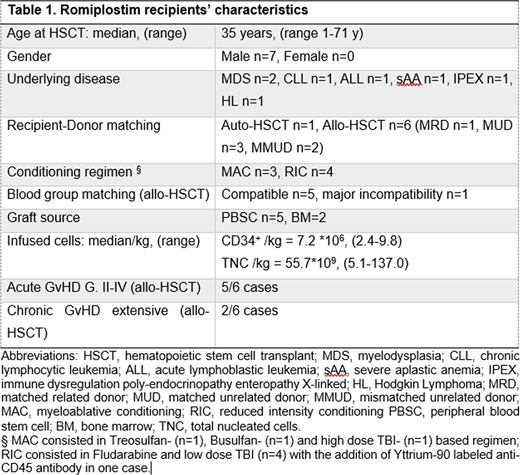Background
Prolonged thrombocytopenia following hematopoietic stem cell transplant (HSCT) is a common complication associated with risks of major bleeding and high platelet transfusion requirements. Although not approved in the setting of post-HSCT thrombocytopenia, few case series have investigated the use of thrombopoietin (TPO)-receptor agonist romiplostim for patients receiving HSCT. Herein, we reviewed its use in the setting of HSCT at our Institution.
Methods
From January 2006 to December 2017, 4642 patients received a first HSCT. Of these patients, 2152 (46%) received an autologous HSCT (auto-HSCT) while 2490 (54%) received an allogeneic HSCT (allo-HSCT). Among the patients in the allo-HSCT group, 752 (30%) received a matched related HSCT, 1125 (45%) a matched unrelated HSCT, 278 (11%) a mismatch unrelated HSCT and 335 (13%) a cord blood HSCT. A reduced intensity conditioning regimen was used in 629 (25%) patients receiving an allogeneic HSCT. An adequate clinical response was considered as a reduction of transfusion requirement and a platelet count PLT ≥ 50*103 /µL. This research was approved by the Institutional Review Board (IRB).
Results
Seven patients (adults n=5, children n=2) received romiplostim for thrombocytopenia. Patients' characteristics are reported in Table 1. All but one (who had CLL-related ITP) received the drug while in remission for the underlying hematologic disease. Romiplostim was used in 6 patients after an allo-HSCT and in 1 after an auto-HCT.
Among the allo-HSCT recipients, all 6 reached neutrophil engraftment at a median time of 19 days (range 14-28 days). Romiplostim was administered for ITP (n=2) and poor graft function (PGF, n=4), at a median time of 7.5 months (range 2 - 34 months), with a median of 16 administrations (range 3-18) per patient. All patients received romiplostim weekly, with a median initial and maximum dose of 1 µg/kg (range 1-3 µg/kg) and 9.5 µg/kg (range 3-10 µg/kg), respectively. For the 2 ITP cases, romiplostim was given as third line of therapy, after a lack of response to both high dose steroids and intravenous immunoglobulin. One patient responded to the treatment, achieving a platelet count ≥ 50*103/µL after 2 months, while the other patient did not show any improvement and the drug was discontinued after 3 months. All the 4 PGF cases were thought to be secondary to medications, with one patient also having acute graft versus host disease (GvHD) as possible cause. Romiplostim was given as first line of treatment in all the cases; median platelet counts at the time of starting the treatment was 21*103/µL (range 13-42*103/µL). One patient did not show any response after 4 months of treatment and was subsequently switched to another TPO receptor agonist. Three patients showed a clinical benefit: one patient achieved a stable platelet count ≥50*103/µL after one month, another patient had a partial response achieving transfusion-independence after 3.5 months, but with PLT counts remaining below 50*103/µL; the third patient had a transient increase in platelet counts with decreased transfusion requirement, but the response was lost after two weeks. Overall romiplostim was well tolerated, with no major side effects related to its administration. In two cases mild increase in reticulin stain (grading 0-1) was observed.
The auto-HSCT patient receiving romiplostim had Hodgkin's Lymphoma and was diagnosed with recurrent ITP 7.5 years after HSCT, while in complete remission for the underlying disease; he received romiplostim as part of the ITP treatment, and responded to a combination of romiplostim and mycophenolate mofetil without reporting adverse events.
Conclusion
In our analysis, the use of romiplostim was limited to very few cases of HSCT. The retrospective nature of this study along with a very small and heterogeneous cohort does not allow us to draw any efficacy conclusions. However, our data suggest that romiplostim could be considered a safe option to treat prolonged thrombocytopenia after HSCT. Prospective, randomized clinical trials using TPO-receptor agonists for thrombocytopenia in HSCT are needed to determine efficacy and potential side effects.
Lawrence:Amgen Inc.: Employment, Equity Ownership. Gernsheimer:Dova pharmaceuticals: Consultancy; Novartis: Honoraria; Amgen: Consultancy, Honoraria; Rigel: Consultancy; Shionogi: Consultancy; Cellphire: Consultancy; Fuji film: Consultancy; Bioverativ: Consultancy. Milano:Amgen: Research Funding; ExCellThera: Research Funding.
We investigated the use of Romiplostim for thrombocytopenia after hematopoietic cell transplant.
Author notes
Asterisk with author names denotes non-ASH members.


This feature is available to Subscribers Only
Sign In or Create an Account Close Modal